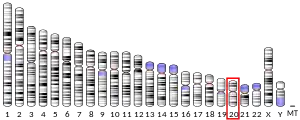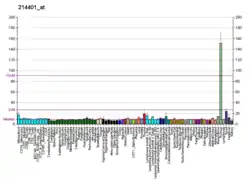Paired box protein Pax-1 is a protein that in humans is encoded by the PAX1 gene.[5][6]
Function
This gene is a member of the paired box (PAX) family of transcription factors which are essential during fetal development. It is required for the development of the ventral vertebral column. Its expression is limited to the pharyngeal pouches and the cells that surround the developing vertebrae near the top where the head will be established to help give rise to the neck and the start of the formation of the shoulders and arm buds. Cancers, such as ovarian and cervical cancers, add a methyl (CH3) group which silences, or disables, the gene which may be able to suppress the tumor by regulating when other cells divide and increase. A substitution or deletion of this gene in mice can produce variants of the mutant undulated which is characterized by segmentation abnormalities along the inner spine. Mutations in the human gene may contribute to the condition of Klippel–Feil syndrome, which is the failure of the vertebrae to segment near the top of the spine and possibly further down with symptoms including a short, immovable neck and a low hairline on the back of the head.[7][8][9][10]
Interactions
PAX1 has been shown to interact with MEOX1[11] and MEOX2.[11]
See also
References
- 1 2 3 GRCh38: Ensembl release 89: ENSG00000125813 - Ensembl, May 2017
- 1 2 3 GRCm38: Ensembl release 89: ENSMUSG00000037034 - Ensembl, May 2017
- ↑ "Human PubMed Reference:". National Center for Biotechnology Information, U.S. National Library of Medicine.
- ↑ "Mouse PubMed Reference:". National Center for Biotechnology Information, U.S. National Library of Medicine.
- ↑ Schnittger S, Rao VV, Deutsch U, Gruss P, Balling R, Hansmann I (December 1992). "Pax1, a member of the paired box-containing class of developmental control genes, is mapped to human chromosome 20p11.2 by in situ hybridization (ISH and FISH)". Genomics. 14 (3): 740–4. doi:10.1016/S0888-7543(05)80177-6. PMID 1358810.
- ↑ "Entrez Gene: PAX1 paired box gene 1".
- ↑ "Genes and Mapped Phenotypes".
- ↑ Hofmann C, Drossopoulou G, McMahon A, Balling R, Tickle C (1998). "Inhibitory action of BMPs on Pax1 expression and on shoulder girdle formation during limb development". Dev. Dyn. 213 (2): 199–206. doi:10.1002/(SICI)1097-0177(199810)213:2<199::AID-AJA5>3.0.CO;2-B. PMID 9786420. S2CID 12943200.
- ↑ Wallin J, Wilting J, Koseki H, Fritsch R, Christ B, Balling R (1994). "The role of Pax-1 in axial skeleton development". Development. 120 (5): 1109–21. doi:10.1242/dev.120.5.1109. PMID 8026324.
- ↑ McGaughran JM, Oates A, Donnai D, Read AP, Tassabehji M (2003). "Mutations in PAX1 may be associated with Klippel-Feil syndrome". Eur. J. Hum. Genet. 11 (6): 468–74. doi:10.1038/sj.ejhg.5200987. PMID 12774041.
- 1 2 Stamataki D, Kastrinaki M, Mankoo BS, Pachnis V, Karagogeos D (2001). "Homeodomain proteins Mox1 and Mox2 associate with Pax1 and Pax3 transcription factors". FEBS Lett. 499 (3): 274–8. doi:10.1016/S0014-5793(01)02556-X. PMID 11423130. S2CID 40668112.
Further reading
- Bannykh SI, Emery SC, Gerber JK, et al. (2004). "Aberrant Pax1 and Pax9 expression in Jarcho-Levin syndrome: report of two Caucasian siblings and literature review". Am. J. Med. Genet. A. 120 (2): 241–6. doi:10.1002/ajmg.a.20192. PMID 12833407. S2CID 1145497.
- Burri M, Tromvoukis Y, Bopp D, et al. (1989). "Conservation of the paired domain in metazoans and its structure in three isolated human genes". EMBO J. 8 (4): 1183–90. doi:10.1002/j.1460-2075.1989.tb03490.x. PMC 400932. PMID 2501086.
- Smith CA, Tuan RS (1994). "Human PAX gene expression and development of the vertebral column". Clin. Orthop. Relat. Res. (302): 241–50. PMID 7909508.
- Stapleton P, Weith A, Urbánek P, et al. (1995). "Chromosomal localization of seven PAX genes and cloning of a novel family member, PAX-9". Nat. Genet. 3 (4): 292–8. doi:10.1038/ng0493-292. PMID 7981748. S2CID 21338655.
- Hol FA, Geurds MP, Chatkupt S, et al. (1996). "PAX genes and human neural tube defects: an amino acid substitution in PAX1 in a patient with spina bifida". J. Med. Genet. 33 (8): 655–60. doi:10.1136/jmg.33.8.655. PMC 1050699. PMID 8863157.
- Wilm B, Dahl E, Peters H, et al. (1998). "Targeted disruption of Pax1 defines its null phenotype and proves haploinsufficiency". Proc. Natl. Acad. Sci. U.S.A. 95 (15): 8692–7. Bibcode:1998PNAS...95.8692W. doi:10.1073/pnas.95.15.8692. PMC 21138. PMID 9671740.
- Stamataki D, Kastrinaki M, Mankoo BS, et al. (2001). "Homeodomain proteins Mox1 and Mox2 associate with Pax1 and Pax3 transcription factors". FEBS Lett. 499 (3): 274–8. doi:10.1016/S0014-5793(01)02556-X. PMID 11423130. S2CID 40668112.
- Deloukas P, Matthews LH, Ashurst J, et al. (2002). "The DNA sequence and comparative analysis of human chromosome 20". Nature. 414 (6866): 865–71. Bibcode:2001Natur.414..865D. doi:10.1038/414865a. PMID 11780052.
- Strausberg RL, Feingold EA, Grouse LH, et al. (2003). "Generation and initial analysis of more than 15,000 full-length human and mouse cDNA sequences". Proc. Natl. Acad. Sci. U.S.A. 99 (26): 16899–903. Bibcode:2002PNAS...9916899M. doi:10.1073/pnas.242603899. PMC 139241. PMID 12477932.
- Eraly SA, Hamilton BA, Nigam SK (2003). "Organic anion and cation transporters occur in pairs of similar and similarly expressed genes". Biochem. Biophys. Res. Commun. 300 (2): 333–42. doi:10.1016/S0006-291X(02)02853-X. PMID 12504088.
- McGaughran JM, Oates A, Donnai D, et al. (2004). "Mutations in PAX1 may be associated with Klippel-Feil syndrome". Eur. J. Hum. Genet. 11 (6): 468–74. doi:10.1038/sj.ejhg.5200987. PMID 12774041.
- Gerhard DS, Wagner L, Feingold EA, et al. (2004). "The Status, Quality, and Expansion of the NIH Full-Length cDNA Project: The Mammalian Gene Collection (MGC)". Genome Res. 14 (10B): 2121–7. doi:10.1101/gr.2596504. PMC 528928. PMID 15489334.
- Giampietro PF, Raggio CL, Reynolds CE, et al. (2005). "An analysis of PAX1 in the development of vertebral malformations". Clin. Genet. 68 (5): 448–53. doi:10.1111/j.1399-0004.2005.00520.x. PMID 16207213. S2CID 9589914.
External links
- PAX1+protein,+human at the U.S. National Library of Medicine Medical Subject Headings (MeSH)
This article incorporates text from the United States National Library of Medicine, which is in the public domain.




